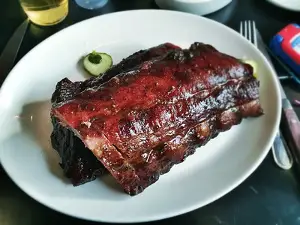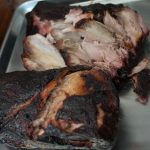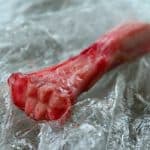
I have already written an article about rib bones and how dog friendly they are.
That article has generated a lot of interest in whether baby back ribs are something that you should consider feeding to your dog.
And so here is my article on it.
Our dogs are difficult to say no to, aren’t they?
The way they tilt their heads and look up at you?
Adorable is an understatement.
But despite this pressure we need to err on the side of caution- no matter how bad your dog wants something, you have to make sure it’s safe for them first.
Here, you’ll discover whether or not you can feed your dogs baby back rib bones, what kind of bones you can feed your dog, safety tips, and more.
Here is what you will learn from reading this article:
- What are baby back rib bones?
- Why do people like them?
- Raw rib bones vs. Cooked rib bones
- Why are baby back ribs good for dogs?
- Why are baby back ribs bad for dogs?
- Safety Tips for Feeding Dogs Bones
- What are the symptoms of an intestinal blockage in a dog?
- If your dog vomits after eating a bone, what should you do?
- Can dogs eat pork rib bones?
- Can dogs eat beef rib bones?
- What are the safest bones a dog can eat?
Ready? Let’s get to it.
What are baby back rib bones?
Baby back ribs can be located underneath a pig’s loin muscles and are a part of the ribs that connect to their backbone.
Most people confuse baby back ribs with spare ribs so, let’s clear up that confusion.
The main difference between the two is that baby back ribs are shorter than spare ribs. The length ranges from 3 to 6 inches.
Why do people like them?
Baby back ribs are popular because they’re soft and tender.
This makes it more appealing to people although, it does also make it more expensive. Baby back ribs, when compared to spare ribs, are also leaner which means they weigh less and cook faster.
Raw rib bones vs. Cooked rib bones
While giving dogs your cooked bones seems safe, don’t do it.
Cooked rib bones lose their hardness making them more fragile.
The more fragile the bones you give your dogs are, the easier they splinter which can cause injury to your dog’s mouth.
The injury gets even worse if they swallow these sharp shrapnels of bone. It could cause internal damage and lead to death.
Raw rib bones are the safer option but, that doesn’t mean you don’t watch your dog when you give them the bone.
Make sure to keep an eye on your dog while they chew on the raw rib bone so you can rush to them if something happens.
Why are baby back ribs good for dogs?
Like most things, feeding your dog bones has its pros and its cons. Here are the pros of feeding your dogs baby back rib bones.
- It’s a great protein source.
The main reason baby back ribs are good for dogs is the pork meat itself.
This meat is a great source of protein.
Protein is a nutrient that offers the necessary amino acids to your dog’s body so it can function properly.
This protein specifically helps with skin and hair, tissue repair, and many more.
- It helps clean their teeth.
Chewing on these rib bones will stimulate saliva enzymes.
These enzymes then keep your dog’s teeth clean by preventing plaque buildup. Baby back rib bones or bones of any kind are great ways to prevent gum disease.
Why are baby back ribs bad for dogs?
While feeding your dog baby backs does have its pros, many veterinarians still don’t suggest feeding your dog bones.
You must be aware of why so you can see for yourself whether dogs can or cannot eat baby back rib bones or bones of any kind.
Baby back rib bones can pose a danger to your pooch so, before giving your best friend this treat, be mindful of the following dangers.
- It’s a choking hazard.
Bones are choking hazards, especially smaller ones. Bones can splinter and break. Once this happens, the smaller pieces can be swallowed by a dog which can cause them to choke.
- It can cut your dog’s mouth.
Bones can also cut a dog’s mouth. Bone pieces are very sharp.
If it ends up in their mouth, it could cut their gums or get lodged into their teeth.
They can also pierce the tongue.
You don’t want to cause your dog pain that could be avoided. If this does happen or you see your dog whining after eating a bone, make sure to visit your vet or give them a call.
- It can cause internal damage.
When swallowed, these sharp bone pieces can pierce internal organs which consequently causes internal bleeding and other gastrointestinal disorders.
They can also cause infections such as peritonitis which is an abdominal bacterial infection that occurs after a bone pierces a dog’s stomach or intestines.
Safety Tips for Feeding Dogs Bones
While we don’t recommend it, you can feed your dog bones.
When you do, make sure to follow these tips to minimize the risk of harm occurring to your dog. Here are some safety tips you should follow when you feed your dogs some bones.
- Monitor them at all times.
Do not leave your dog alone when they’re eating a bone.
If you’re away from them or you’re not monitoring them, who knows what could happen?
Your dog might end up choking or swallowing a piece of bone.
You must always be aware of what they’re doing while chewing a bone so you can offer proper assistance when needed.
- Avoid cheap bones.
If you’re buying processed bone treats for your dog, do not buy them from brands you do not trust. You’re never sure if they’re too brittle.
Brittle bones splinter easily which is a choking hazard, could cut a dog’s mouth, and when swallowed, could cause internal damage.
- Choose the right bone for your dog.
This is something you should never forget.
Give your dogs the right size bone.
Make sure to get them bones you would normally think are too big for them.
The smaller the bone, the easier it is to choke on or swallow.
Choosing the right bone for your dog is a must for a more enjoyable and safer experience.
What are the symptoms of an intestinal blockage in a dog?
An intestinal blockage, as the name suggests, occurs when a dog’s stomach or intestines become blocked either partially or completely.
If you do not take your dog to the vet to get treated, your dog can die of this.
That’s why it’s important to take note of these symptoms.
If you notice your dog experiencing any or multiple of them, be sure to bring them to the vet to get checked out.
- Loss of appetite
- Bloating
- Dehydration
- Restlessness
- Nausea
- Diarrhea
- Weakness
- Abdomen is painful when touched
- Whining and whimpering
- Difficulty pooping
If you notice your dog showing or experiencing these symptoms, call your local veterinarian immediately.
If your dog vomits after eating a bone, what should you do?
When your dog vomits after eating a bone, it could be a sign that they swallowed bone shrapnel. These shrapnel could be irritating the stomach, cutting into organs, and the like.
At this point, do not try to treat them yourselves. Instead, bring them to the veterinarian immediately.
The vet will be able to check and make sure that your dog has not swallowed a bone or that there is nothing lodged within your dog’s esophagus, stomach, intestines, and the like.
After the check-up, follow your vet’s instructions carefully to make sure your dog heals properly.
Can dogs eat pork rib bones?
Pork rib bones are not recommended for dogs.
They’re easy to splinter regardless of whether they’re raw or cooked.
Once the bone cracks, your dog might swallow tiny bone pieces which leads to many health hazards.
Can dogs eat beef rib bones?
Beef rib bones are considered a safer type of bone for your dog to chew on because they aren’t easy to break.
All you have to do is make sure that your dog is chewing on a raw beef bone instead of a cooked one and that you’re monitoring them while chewing.
Bones in general are not recommended treats but, you can give them to your dog if you want to.
What are the safest bones a dog can eat?
Raw bones are the safest bones for your dog but, that’s pretty general. What specific raw bones are safe for your dog to eat?
The best bones to feed your dog are bones from cows and bison.
These bones are soft but not soft enough for your dog to be able to easily break pieces off.
These bones are also often large minimizing the risk of choking.




